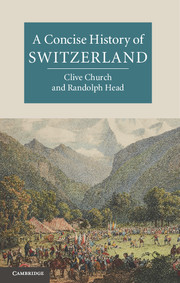Book contents
- Frontmatter
- Contents
- List of Illustrations
- List of Figures
- List of Maps
- Acknowledgements
- List of Abbreviations
- Introduction Making the Swiss
- 1 Before Switzerland
- 2 Creating the Swiss Confederacy, 1386–1520
- 3 A divided Switzerland in Reformation Europe, 1515–1713
- 4 The Ancien Régime, 1713–1798
- 5 Revolution and contention, 1798–1848
- 6 Forging the new nation, 1848–1914
- 7 The shocks of war, 1914–1950
- 8 The Sonderfall years, 1950–1990
- 9 Since 1989
- Chronology
- Glossary
- Further Reading
- Index
5 - Revolution and contention, 1798–1848
Published online by Cambridge University Press: 05 June 2013
- Frontmatter
- Contents
- List of Illustrations
- List of Figures
- List of Maps
- Acknowledgements
- List of Abbreviations
- Introduction Making the Swiss
- 1 Before Switzerland
- 2 Creating the Swiss Confederacy, 1386–1520
- 3 A divided Switzerland in Reformation Europe, 1515–1713
- 4 The Ancien Régime, 1713–1798
- 5 Revolution and contention, 1798–1848
- 6 Forging the new nation, 1848–1914
- 7 The shocks of war, 1914–1950
- 8 The Sonderfall years, 1950–1990
- 9 Since 1989
- Chronology
- Glossary
- Further Reading
- Index
Summary
The French invasion of 1798 unleashed both a political revolution in Switzerland and a half-century of contention over the validity and nature of the new polity that then emerged. This contention, moreover, took place much more within a single Swiss political arena than had been the case before, so that increasingly it becomes possible to look at Switzerland in terms of a single narrative. This began in 1798 when the old order was overthrown by a combination of its own weaknesses, the work of a nationally minded minority and French military muscle. Together, the possibility of armed intervention and the clear impotence and bad faith of the Ancien Régime liberated the enthusiasm of patriot forces. Because of French military backing, the country had to accept the replacement of the old order by a new centralized Helvetic Republic, which however found itself plagued by contention over its nature, its powers and even its very existence. Consequently, although it superficially united the country and ended the old Confederacy, the Helvetic regime never succeeded in creating a stable state. Much conflict and argument over the precise nature of the new polity was to follow before this was finally achieved in 1848.
Indeed, the Helvetic Republic very soon descended into civil war, which allowed Napoleon to impose a compromise solution that earned the Swiss a few years of relative stability and prosperity. But with his fall came the resurgence of older forces. In 1815 the Great Powers managed to temper the cantons’ reactionary aspirations to some extent when they endowed the country with a conservative Confederal Charter. However, the post-war regime was then challenged by the Holy Alliance and by disgruntled liberal supporters of the post-1798 reforms. Aided by the increasing pace of industrialization the liberals broke through in 1830 and ‘regenerated’ the constitutions of most cantons, ending all hopes of a return to an Ancien Régime dominated by capital cities and their elites.
- Type
- Chapter
- Information
- A Concise History of Switzerland , pp. 132 - 161Publisher: Cambridge University PressPrint publication year: 2013



